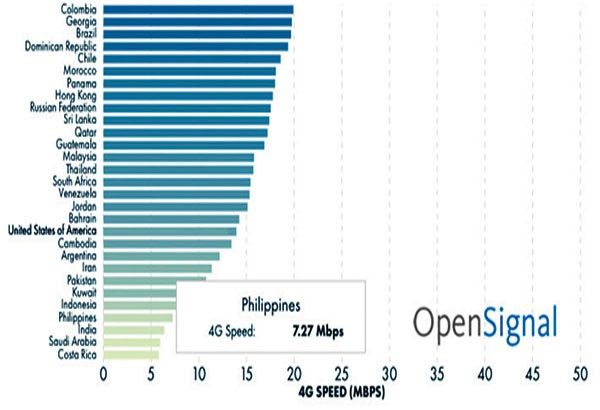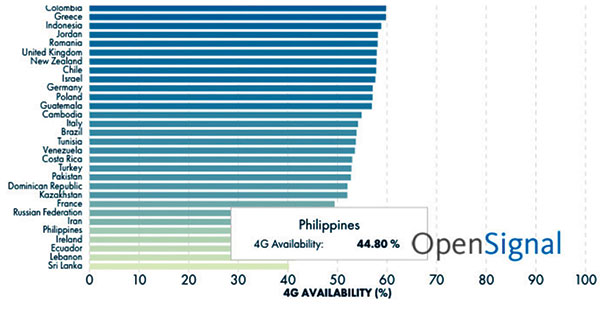Philippines still lags behind in LTE connectivity

The most recent survey reported by OpenSignal points to the Philippines close to the bottom of the rankings among 78 countries.
The report is based on a survey conducted from July 1 to Sept. 30 with a little over 500,000 in sample size.
The measurements taken during this survey refers to the average LTE speed and availability.
In terms of average LTE speeds, the Philippines ranked at #75 or fourth to the last. The average reported speed is 7.27Mbps, a slight drop from the same quarter a year ago at 8Mbps.
In terms of 4G availability, the Philippines likewise ranked poorly at #74 or fifth from last with only 44.8 percent.

Obviously, the results are still disappointing. There’s still very little improvement, if any at all, from our local telcos.
What’s interesting about these results is that the survey was done around the third to fifth month after PLDT and Globe bought out the telco assets of San Miguel. This was supposed to be the same time period that the chief executives of both telcos promised significant improvements in their network.
One of the biggest assets that was included in the deal with San Miguel is the 700MHz spectrum. In this frequency, tower signals are supposed to reach a wider area and penetrate buildings and solid walls. In a way, this is supposed to solve the need to build additional cell sites. The wider coverage per cell site would also mean that there should be higher 4G availability.
The additional frequency should also mean the towers can transmit data at higher bandwidth, reducing congested networks. Less congestion should result to faster download speeds. Again, the 7.27Mbps average LTE speed landed us in 75th place. Just to get the perspective right, in the same report, Singapore got an average of 45.9Mbps putting it at the top followed by South Korea at 45.8Mbps.
This brings us back to the main reason why SMC telco assest were bought in the first place. It was supposed to help improve the speed and coverage of mobile internet in the Philippines. The OpenSignal report did not indicate any significant improvements.
Perhaps it’s too early to really see the effects? PLDT promised six months while Globe promised four months – or they were just too optimistic about their estimates. I hope it’s just a delay in the roll-out. Let’s give them a few more months.
Results for first quarter of 2017 should be a good enough time frame to really see the promised improvements in speed and coverage. If, by then, the results showed otherwise we will really know why they bought out SMC — and that’s not because they really want to improve their services. We’ll find out soon enough.
- Latest


























